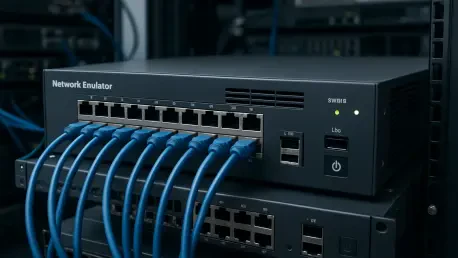The world of networking technology is undergoing a seismic shift, and at the heart of this transformation lies the critical role of network emulators, tools designed to replicate real-world network conditions for testing and optimization. A recently released comprehensive report, published on August 27, has cast a spotlight on the global network emulator market, offering an in-depth evaluation of over 100 companies and identifying the top 15 as quadrant leaders through a sophisticated analytical framework. These emulators, essential for simulating network impairments like packet loss and latency, have become indispensable in ensuring quality assurance and troubleshooting in virtual environments. As businesses navigate increasingly complex digital infrastructures, the insights from this analysis reveal not only the current state of the market but also the innovative forces driving its evolution. This pivotal study underscores the growing importance of such tools in a landscape dominated by virtualization and digital transformation.
Driving Forces Behind Market Growth
The surge in demand for network emulators is intricately tied to the rapid adoption of software-defined networking (SDN) and virtualization technologies across industries. As organizations pivot toward virtual environments to manage sprawling network architectures, the need for robust testing tools has never been more pronounced. Network emulators enable the simulation of real-time conditions, allowing companies to assess application responsiveness and end-user experience without the prohibitive costs of physical setups. This capability is vital for decision-making processes, ensuring that resources are allocated efficiently while mitigating risks associated with network failures. Beyond mere functionality, these tools support a broader trend of digital transformation, where seamless connectivity and performance are non-negotiable. The report highlights how this demand is reshaping the competitive landscape, pushing companies to innovate relentlessly to meet the evolving needs of a tech-driven world.
Moreover, the growth trajectory of the network emulator market is fueled by an increasing emphasis on performance optimization and risk management. Businesses are under constant pressure to deliver flawless digital experiences, making the ability to simulate and troubleshoot network issues in a controlled setting a game-changer. The analytical insights from the report point to a market that thrives on the intersection of technological advancement and strategic necessity. Emulators not only facilitate proof of concept for new configurations but also play a critical role in preempting potential disruptions through proactive testing. This dual functionality underscores their value in an era where downtime can translate to significant financial and reputational losses. As virtualization becomes integral to modern networking, the reliance on these specialized tools is expected to intensify, setting the stage for sustained market expansion over the coming years.
Key Players Setting the Pace
Among the numerous companies evaluated, industry giants such as Spirent Communications, Keysight Technologies, and VIAVI Solutions have emerged as frontrunners, distinguished by their innovative approaches and expansive product portfolios. Their leadership is not merely a result of market presence but stems from substantial investments in research and development, enabling the rollout of cutting-edge solutions that address complex networking challenges. Strategic partnerships and collaborative initiatives further amplify their global reach, positioning them as benchmarks in a highly competitive field. The report meticulously maps their standing based on critical metrics like revenue streams, geographic influence, and growth strategies, offering a clear perspective on why these firms dominate. Their ability to anticipate market needs and deliver tailored solutions cements their status as quadrant leaders in this dynamic sector.
Additionally, the competitive edge of these top players is reflected in their adaptability to emerging trends and customer demands. Beyond innovation, their success hinges on a keen understanding of the market’s pulse, allowing them to forge alliances that enhance technological capabilities and market penetration. The analysis reveals a landscape where staying ahead requires not just technical prowess but also strategic foresight to navigate challenges and seize opportunities. For Spirent, Keysight, and VIAVI, leadership is about setting industry standards through consistent performance and visionary planning. Their comprehensive sales approaches and customer-centric solutions ensure they remain at the forefront, guiding the direction of network emulator advancements. As the market continues to evolve, their influence is likely to shape how other companies approach competition and innovation in this space.
Future Pathways and Strategic Insights
Reflecting on the findings, it’s evident that the network emulator market witnessed a defining moment with the release of this detailed evaluation. The top companies demonstrated unparalleled commitment to pushing technological boundaries, setting a precedent for others in the industry. Their efforts in simulating real-world network conditions helped organizations worldwide optimize performance and reduce operational risks in virtual settings. The emphasis on innovation and collaboration among these leaders provided a roadmap for addressing the complexities of modern networking challenges. Looking back, their contributions were instrumental in highlighting the indispensable role of emulators in a digital-first era.
Moving forward, stakeholders should consider leveraging the insights from this analysis to inform strategic decisions and investments. Prioritizing partnerships with leading firms could unlock access to advanced solutions tailored for future-ready networks. Additionally, focusing on integrating emulator technologies with emerging SDN frameworks might offer a competitive advantage. As the industry progresses, continuous adaptation to technological shifts will be crucial for maintaining relevance. Exploring opportunities for innovation in testing methodologies could further enhance network reliability. These actionable steps, inspired by the achievements of market leaders, pave the way for sustained growth and resilience in an ever-changing digital landscape.









